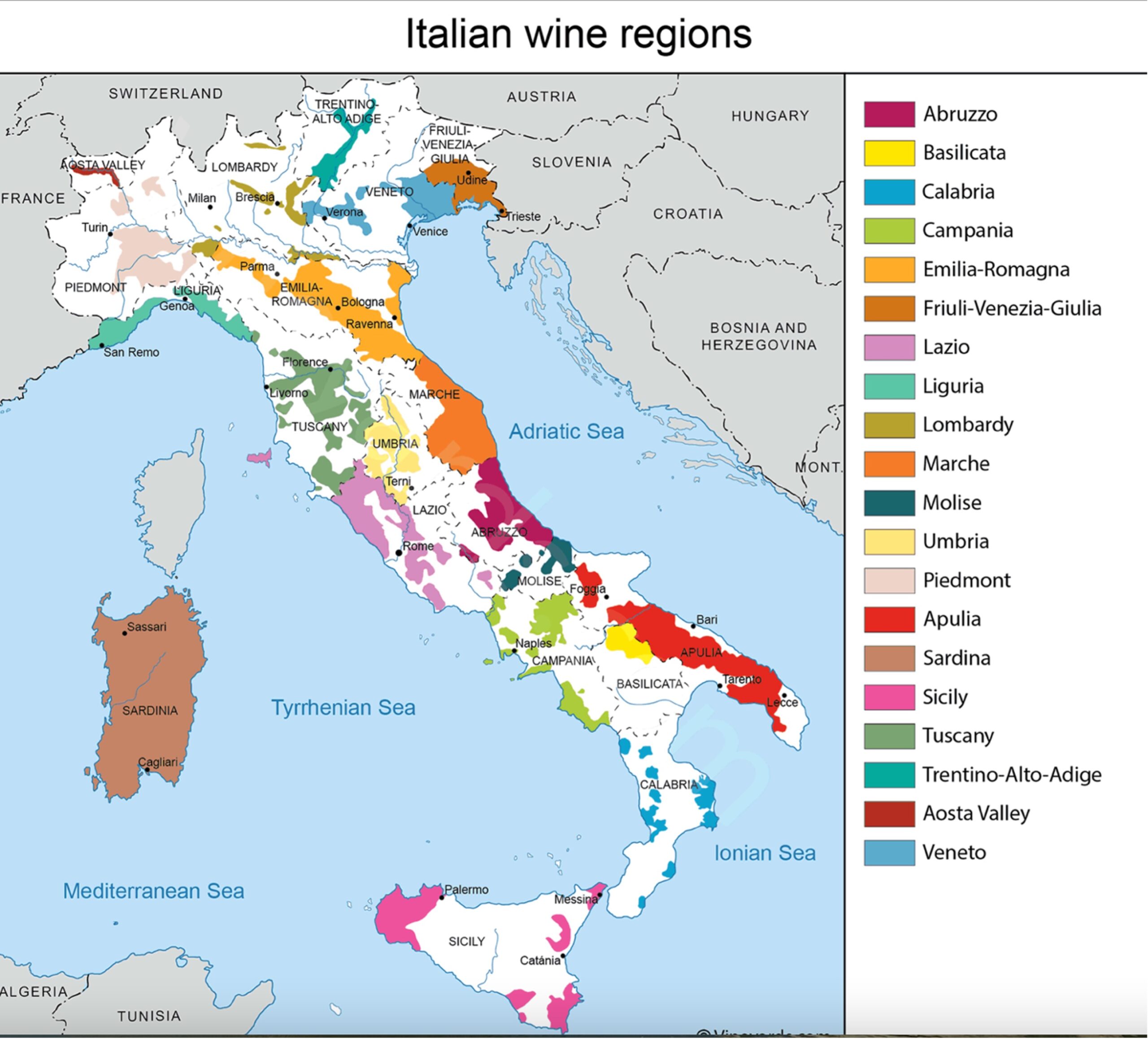By Joyce Tarantino, Italian Wine Scholar
From the highest slopes in Europe for vine cultivation under the shadow of Mont Blanc to the windswept volcanic landscape on the island of Pantelleria, there is a wine for every palate.
While Italy has 350 registered grape varieties, some 1,500 different varieties are actually found here and most are grown nowhere else in the world. Just for comparison, France has 250 registered grapes and over 95% of production comes from only 40 varieties!
Here’s a quick trip around the regions. Then we’ll take a deep dive weekly into the wines and the food specialties of each place. I’ll mention a few of my favorite producers and where to shop for wine in Rome and beyond. Settle into your armchair, pick up a bottle from each region and get ready to travel. See you next week!

Map photo: Vineyards.com
Valle d’Aosta
- Far NW corner of Italy, near France and Switzerland
- Smallest population and wine production
- Cultivation on steep slopes, some over 3500 ft in elevation; heroic viticulture
Piemonte
- SW of Milan and NW of Genoa
- Italy’s powerhouse for wine quality and home to white truffles
- Barolo – “The wine of kings and King of Wines”
Liguria
- NE coast between Nice and Tuscany
- Best known for the Cinque Terre territory and its heroic viticulture
- The Italian Riviera
Lombardia
- Fashion and financial capital of Italy – Milan
- Franciacorta – the champagne style wines of Italy
- Pinot Nero (Pinot Noir), sparkling and still, of the Oltrepo
Trentino/Alto Adige
- NE border with Austria and Switzerland
- Italian and German are official languages
- Grape varieties more commonly associated with Germany
Friuli Venezia Giulia
- Far NE corner of Italy on the border with Austria and Croatia
- On the Adriatic from Venice to Trieste
- Famous for some of Italy’s best white wines
Veneto
- South of the Alto Adige and west of Friuli – together they form the ‘Tre Venezie’
- Prosecco and Amarone are the region’s claim to fame
- Verona and Venice are the two most prominent cities
Emilia Romagna
- One of Italy’s oldest wine regions and oldest native grape varieties – Lambrusco
- Food trifecta – Balsamic vinegar, Prosciutto di Parma, Parmigiana cheese
- Home to Ferrari, Lamborghini and Maserati automobiles
Toscana
- Produces two of Italy’s most well-known wines, Brunello di Montalcino and Chianti
- Best expression of the Sangiovese grape variety
- Florence, the art capital of Italy
Marche
- On the east coast of Italy, from the Apennine mountains to the Adriatic Sea
- Noted for its white wines, Pecorino, Passerina and Verdicchio
- Verdicchio – one of the most perfect pairings for seafood
Umbria
- In the landlocked center – the “Green Heart of Italy”
- Known for its white wines around Orvieto and red from Montefalco
- Celebrated for chocolate from Perugia, salumi from Norcia and St Francis of Assisi
Lazio
- In the center of Italy on the west coast, from the Apennine mountains to Tyrrhenian Sea
- Home to Rome, the Eternal City
- Known for its white wines especially from the Castelli Romani
Campania
- On west coast bordering the Mediterranean Sea
- Naples – the pizza capital of Italy and strong tradition of pastries
- Ancient wine-producing stronghold of the Romans
- Volcanic soils of Mt Vesuvius produce high quality grapes and tomatoes
- Outstanding white wines and one of Italy’s top three reds, Aglianico
Abruzzo
- Location is the eastern Adriatic coast, directly across the peninsula from Rome
- On the spine of the Apennines, it is rugged and rocky
- Noted for hearty reds and bright deep color rose, Cerasuolo d’Abruzzo
Molise
- North of Puglia and south of Abruzzo on the Adriatic coast, opposite Naples
- Mountainous terrain
- Produces red and white wines for its hearty cuisine
Puglia
- the “heel of the boot” of the Italian peninsula; miles of coastline on the Adriatic and Ionian seas
- Famous for Primitivo, known as Zinfandel in California and other bold reds
- Outstanding vegetarian dishes, mussels from Taranto and orecchiette “little ears” pasta
Sicily
- Largest island in the Mediterranean
- Mt Etna, Europe’s highest active volcano, is at the forefront of the Italian wine scene
- Ancient viticulture traditions from the Greeks
- Produces red and white as well as outstanding passito dessert wines
- Famous for its tuna, pasta dishes, gelato and pastries, especially from almond paste
Sardegna
- Island off the west coast of Tuscany known for its spectacular beaches; 2nd largest after Sicily
- Mostly grape varietals of Spanish and French origins, like Grenache and Carignano
- Herds of sheep and pecorino cheese are synonymous with Sardegna
